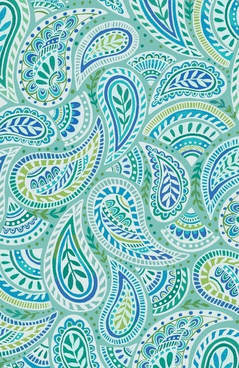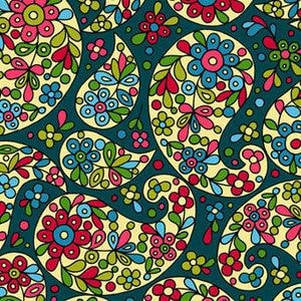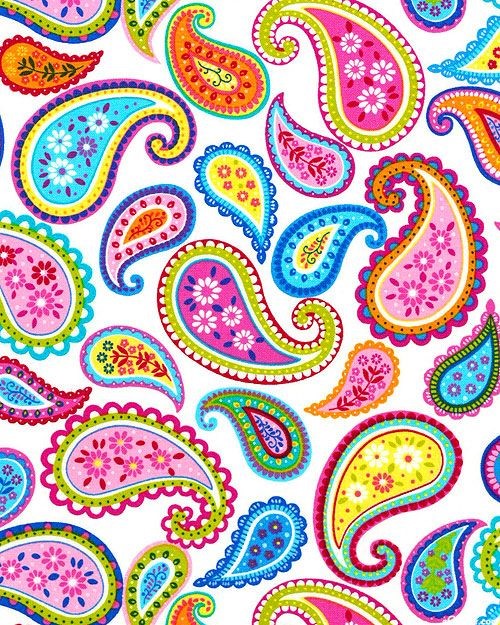|
The term “paisley” was introduced when soldiers returned from Persia to the town of Paisley, Scotland. The Kashmir shawls they brought home as gifts were reproduced in Paisley’s cotton and woolen mills
|
Paisley is a droplet-shaped vegetable motif of Persian and Indian origin. It resembles a twisted teardrop that is kidney-shaped. There are many stories about the origin of paisley. But whatever they are, one thing is clear—it has gone a long way and it has influenced many designs around the globe.
|
The textiles originally combined fine hand-dyed yarn and metallic fibers for use by royalty. Eventually all fabric used the Buta design for regular clothing and household goods such as tablecloths. Many of these patterns were repeated on a plain cloth with a hand-carved wooden stamp. |
Goals and Objectives Goal:
You will describe and place a variety of art objects in historical and cultural contexts Objectives: 1. You will review and discuss the origin of the paisley pattern. 2. You will review exemplar paisley patterns for reference. 3. You will use french curves to create your paisley design on white paper. 4. You will use colored pencil to complete your design. Materials:
|
Vocabulary1. Paisley: A pattern of colorful and detailed figures.
2. Overlap: When one object or shape is partially placed on top of another. 3. Pattern: The repetition of lines and shapes. 4. French Curve: A template made of plastic with the edges cut in scroll like curves. 5. Textile: Any cloth produced by knitting or weaving. |
Procedure:
1. Each student starts with one sheet of 12" x 18" white construction paper. Use the French curves to draw outlines of three or more shapes onto the paper. Do not overlap shapes, let them float. Fill white space with a French curve shape that runs off the paper.
2. Choose two or three pieces of colored construction paper. Use the French curves to draw outlines of shapes onto paper and cut out. Set aside for Step 4.
3. Make the pattern designs using the colored pencils. Follow the inside of the curved shape. Start the colored pencil on the white paper shapes already drawn. The white paper should not show when the artwork is finished.
4. Design the colored paper paisley shapes when done, place these in the blank white areas where needed. Some may now overlap, or cut to make them look overlapped. Glue them in place. Use a small piece of cardboard to spread glue on the cut shape.
5. Negative space between the paisley shapes may now be filled with colored pencil designs. Follow the outer contours of the shapes until the entire page is filled.
Assessment:
1. You will be evaluated on your design, using overlap and Pattern
2. You will be evaluated on your coloring skills
3. You will be evaluated on your overall composition
4. You will complete your project in a timely manner
5. You will be evaluated on the results of your vocabulary test
National Standards Content Standard
#4 — Understanding the visual arts in relation to history and cultures K-4 Students identify specific works of art as belonging to particular cultures, times, and places
5-8 Students describe and place a variety of art objects in historical and cultural contexts
#5 — Reflecting upon and assessing the characteristics and merits of their work and the work of others K-4 Students understand there are different responses to specific artworks 5-8 Students describe and compare a variety of individual responses to their own artworks and to artworks from various eras and cultures
#6 — Making connections between visual arts and other disciplines K-4 Students identify connections between the visual arts and other disciplines in the curriculum 5-8 Students compare the characteristics of works in two or more art forms that share similar subject matter, historical periods, or cultural context
#4 — Understanding the visual arts in relation to history and cultures K-4 Students identify specific works of art as belonging to particular cultures, times, and places
5-8 Students describe and place a variety of art objects in historical and cultural contexts
#5 — Reflecting upon and assessing the characteristics and merits of their work and the work of others K-4 Students understand there are different responses to specific artworks 5-8 Students describe and compare a variety of individual responses to their own artworks and to artworks from various eras and cultures
#6 — Making connections between visual arts and other disciplines K-4 Students identify connections between the visual arts and other disciplines in the curriculum 5-8 Students compare the characteristics of works in two or more art forms that share similar subject matter, historical periods, or cultural context



